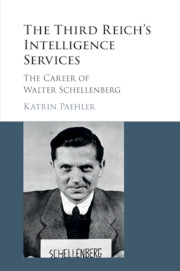Book contents
- Frontmatter
- Dedication
- Contents
- List of Figures
- Acknowledgments
- Archives
- Introduction
- 1 Gaining a Foothold
- 2 Rising Star
- 3 Intelligence Man
- 4 Office VI and Its Forerunner
- 5 Competing Visions: Office VI and the Abwehr
- 6 Doing Intelligence: Italy as an Example
- 7 Alternative Universes: Office VI and the Auswärtige Amt
- 8 Schellenberg, Himmler, and the Quest for “Peace”
- 9 Postwar
- 10 Concluding Thoughts
- Appendix
- Glossary
- Index
2 - Rising Star
Published online by Cambridge University Press: 31 March 2017
- Frontmatter
- Dedication
- Contents
- List of Figures
- Acknowledgments
- Archives
- Introduction
- 1 Gaining a Foothold
- 2 Rising Star
- 3 Intelligence Man
- 4 Office VI and Its Forerunner
- 5 Competing Visions: Office VI and the Abwehr
- 6 Doing Intelligence: Italy as an Example
- 7 Alternative Universes: Office VI and the Auswärtige Amt
- 8 Schellenberg, Himmler, and the Quest for “Peace”
- 9 Postwar
- 10 Concluding Thoughts
- Appendix
- Glossary
- Index
Summary
Schellenberg is one of my best and work-wise one of my most reliable supports.
Reinhard Heydrich, 1939In the last years of the 1930s, and under the tutelage of Reinhard Heydrich, Walter Schellenberg ascended rapidly through the ranks of the SD. Beginning in 1938 and making use of Schellenberg's legal training, his keen understanding of key administrative issues, his ability as a negotiator, and his zealous drive to succeed, Heydrich began to rely on Schellenberg for the solution of complicated legal and administrative issues and, due to the former's conflict with Werner Best, Schellenberg moved into position as Heydrich's legal expert of choice. By late 1939, Schellenberg had parlayed his abilities and ambitions into the position of a department head in the Gestapo and had acquired the reputation of a rising star. He was on good terms with Heydrich – and his wife Lina – and increasingly also with Heinrich Himmler. How did this development come about and what does it say about Walter Schellenberg, the SD, and Nazi Germany's intelligence and security complex?
In 1938 and 1939, long-simmering institutional conflicts between the Security Police and the SD came to the fore, as the respective leaderships became embroiled in an argument of far-reaching ramifications. The initial issue at stake was the planned amalgamation of the Security Police, a state organization, and the SD, a quintessential party organization, into one entity. In this process, which led to the establishment of the Reichssicherheitshauptamt, Reich Security Main Office, in the fall of 1939, both the Security Police and, even more so, the SD, its role, and mandate were defined. Much of this was Schellenberg's doing. This discussion then led to a debate about career paths in both Security Police and SD. Outwardly a curious development, the latter debate went to the core of the issue: who was to lead in the new state based on which qualifications? Ultimately, the question was about how far the Nazi revolution would go and how radical and ideologically defined the new state – and its coming Empire – would be. Would it displace German bureaucratic and civil service traditions and create a new caste of leaders?
- Type
- Chapter
- Information
- The Third Reich's Intelligence ServicesThe Career of Walter Schellenberg, pp. 46 - 75Publisher: Cambridge University PressPrint publication year: 2017

